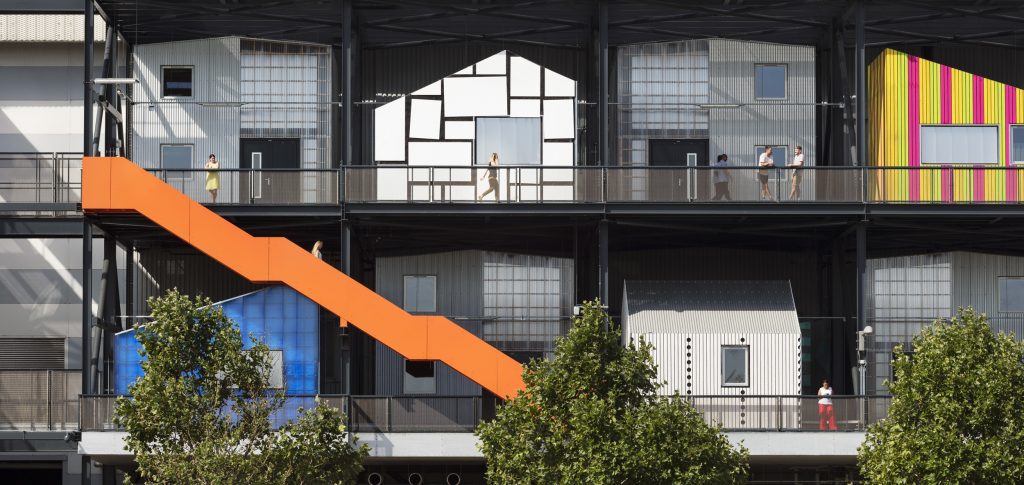- Research shows that values in creative clusters outperformed the London average by 4.4% per annum over 10 years.
- Research concludes that creative workspace as a ground floor commercial use does not add material risk and can add value.
- Values in creative clusters in the Thames Estuary outperformed the area average by 3.3% per annum over 5 years.

16 SEPTEMBER 2021: Creative Land Trust, in collaboration with Get Living and Creative Estuary, has published research that has found a positive association between the presence of creative workspace and residential property values.
The evidence suggests there is a financial value to benefits that creative industries bring to residential areas, expressed in house price data. Over a 10-year time frame this amounted to 4.4% per annum price outperformance above the wider London residential market – a total of 44% over the 10 years. The per annum outperformance ranged from a high of 10% per annum (London City Island) through to 2% per annum (Hackney Wick / Fish Island).
The research uses house price data in various locations recognised as clusters of creative workspaces, analysed over various time frames, in order to identify the level of outperformance in house price data relative to the wider market. It focusses on case studies of creative clusters in London (Hackney Wick, Woolwich Dockyard & Tottenham) and the Thames Estuary (Margate, Southend, Basildon, Thurrock & Medway), and standalone schemes where creative workspace had been included in a residential scheme in London (Galleria in Peckham, Bow Arts in Royal Albert Docks, ASC Arthouse in Croydon & Second Floor Studios in Wembley).
The outperformance in residential values is comparable to the local economic effect associated with large-scale urban regeneration, green or blue spaces, popular schools, or certain grocery stores being adjacent to homes.
The risk analysis in this research also demonstrates that creative workspace as a ground floor use in a residential development does not introduce any additional risk and can increase investment value where there is a good covenant and secure long-term income (or a long leasehold sale). Therefore, the report posits that professionally managed creative workspace is often a more viable and financially attractive option than other commercial uses because it offers long term secure income, particularly appealing in uncertain times.
Ailish Christian-West, Director of Real Estate, commented:
“There is widespread understanding that the presence of creative workspace in a community has an impact on the long-term success of a place and therefore an implied contribution to value. But isolating and quantifying the specific financial value that can be traced back to this reality is hard. Get Living has long understood this value, which is why we invest in creative spaces at our neighbourhoods, such as The Lab in East Village.
“For other developers to be encouraged to make creative workspace part of a scheme then evidence such as that set out in the Creative Land Trust’s research showing how values can outperform over the longer term is useful.”
Gordon Seabright, chief executive of Creative Land Trust, commented:
“The ultimate purpose of this research study is to help expand the provision of affordable workspace for creatives by presenting developers with evidence to show that creative workspace can make an important contribution to financial value in a residential-led development.
“This relationship is not hard to verify but there are of course, a multitude of factors that influence house prices. What this research does is translate the widely acknowledged ‘soft value’ of creative space into a ‘hard value’ that can be accepted by investors and developers for use in evaluating development opportunities and encourage them to re-examine the risk-return trade-off of creative workspace as a ground floor use.”
Emma Wilcox, Project Director of Creative Estuary, commented:
“It has long been acknowledged that cultural and creative industries can bring vibrancy and economic growth to an area. In many cases this growth has been organic. Creative people seeking affordable workspaces often found them in old industrial land on the city fringe, in places like Hackney Wick or Woolwich Dockyard in London, or in areas with the lifestyle appeal of heritage, natural landscape, and more affordable property, including in Southend and Margate in the Thames Estuary.
“Clusters of creative space over time gained critical mass and recognition. Successful places attract demand for housing and in a market economy with constrained supply, demand almost inevitably translates into rising property values, which has the potential to displace creative workspace and disrupt creative communities. Through our work at Creative Estuary, we are exploring new models and partnerships to ensure our industry continues to thrive.”
Justine Simons, Deputy Mayor for Culture and the Creative Industries commented:
“Creative space brings life and vibrancy to London, it’s part of its DNA. That’s why the Mayor has supported London’s first ever Cultural Infrastructure Plan and the Creative Land Trust – to make sure it’s embedded in London for the future. This report demonstrates that there is a good economic foundation to support creative infrastructure for residential-led developments and their communities.”
The author team for the research report was Hawkins/Brown, dataloft and Ramidus Consulting.